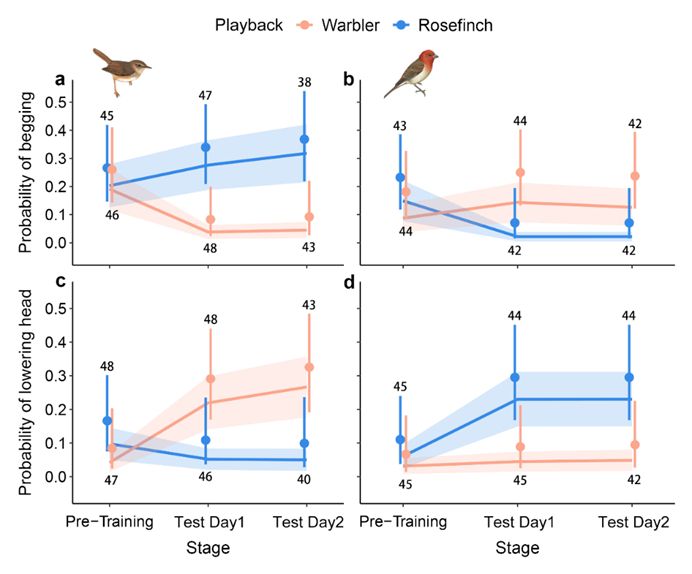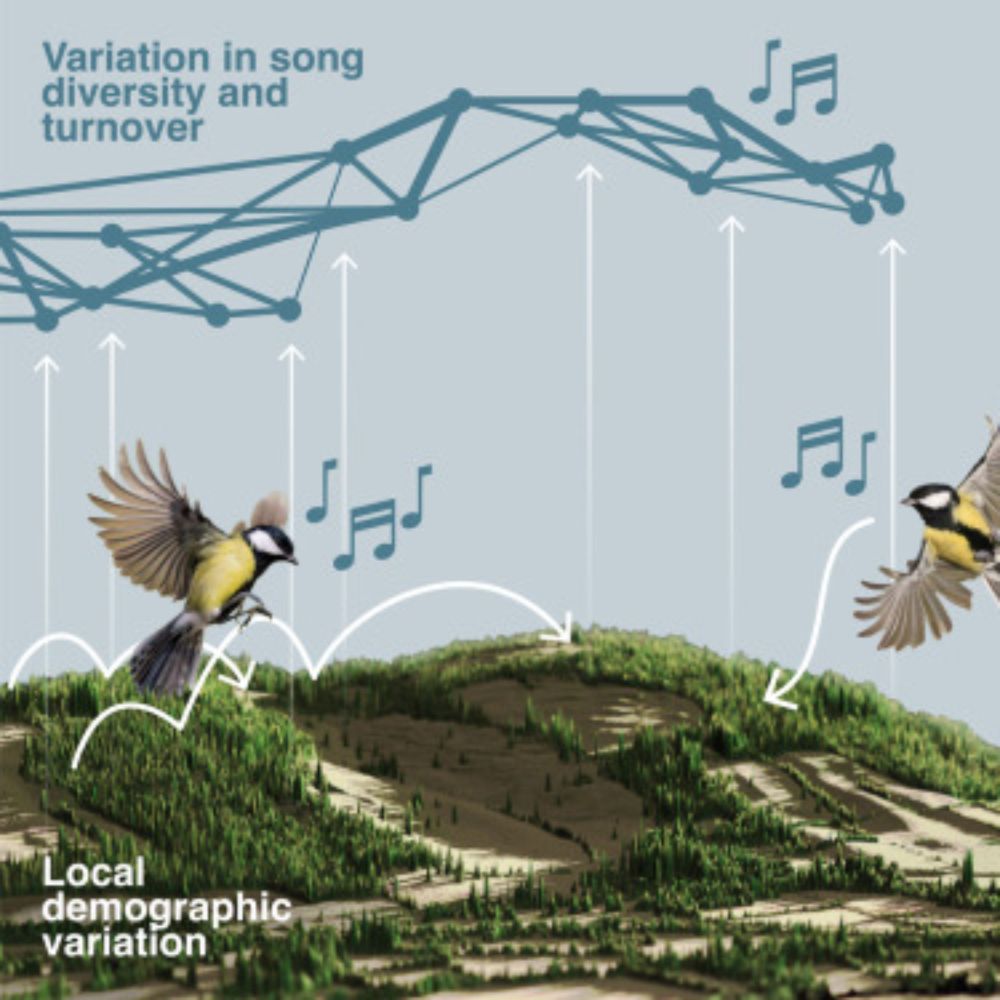These findings show that redstart chicks can learn to recognize novel alarm calls by associating them with familiar alarm calls. This demonstrates that nestling birds eavesdrop on the alarm calls of other species through acoustic association.
16.07.2025 05:58 — 👍 1 🔁 0 💬 0 📌 0
When we first played back the novel calls, the nestlings showed no response. We then played the unfamiliar call six times together with redstart alarm calls. After this training phase, nestlings responded to the novel call in the same way as to alarm calls of their own species.
16.07.2025 05:58 — 👍 2 🔁 0 💬 1 📌 0
However, parents are not always around to warn them. Alarm calls from other species may then provide an additional valuable source of information. We tested whether nestling redstarts can learn to recognize unfamiliar calls by associating them with known alarm calls from their own species.
16.07.2025 05:58 — 👍 1 🔁 0 💬 1 📌 0
Predators pose a major threat to nestling birds, so it is important that nestlings recognize and respond to signals that indicate danger. When their parents make alarm calls, for instance, chicks typically stop begging and crouch down to avoid being detected.
16.07.2025 05:58 — 👍 1 🔁 0 💬 1 📌 0

New paper led by Jinggang Zhang just out in @royalsocietypublishing.org! We show that nestling redstarts learn to respond to calls of other species if hear them together with alarm calls of their own species doi.org/10.1098/rspb...
16.07.2025 05:58 — 👍 12 🔁 4 💬 1 📌 0
However, parents are not always around to warn them. Alarm calls from other species may then provide an additional valuable source of information. We tested whether nestling redstarts can learn to recognize unfamiliar calls by associating them with known alarm calls from their own species.
16.07.2025 05:51 — 👍 0 🔁 0 💬 0 📌 0
Predators pose a major threat to nestling birds, so it is important that nestlings recognize and respond to signals that indicate danger. When their parents make alarm calls, for instance, chicks typically stop begging and crouch down to avoid being detected.
16.07.2025 05:51 — 👍 0 🔁 0 💬 1 📌 0
Spectacular!
08.06.2025 07:18 — 👍 1 🔁 0 💬 1 📌 0
We conclude that breeding site fidelity may be a beneficial strategy for individuals that are successful in a certain location, even in species that are generally nomadic. Big thanks to the co-authors and the many people that contributed to data collection! 6/6
24.03.2025 08:49 — 👍 2 🔁 0 💬 0 📌 0

Males that returned to the study area also had higher siring success and stayed longer in the study area than males that had not been in the study area the previous year 5/6
24.03.2025 08:49 — 👍 1 🔁 0 💬 1 📌 0

Males that had higher siring success and had stayed in the study area for longer were more likely to return 4/6
24.03.2025 08:49 — 👍 1 🔁 0 💬 1 📌 0

However, a very small proportion of ~900 colour banded pectoral sandpipers did return to their former breeding site in the subsequent breeding season, with males returning more often (2.4%) than females (0.5%) 3/6
24.03.2025 08:49 — 👍 1 🔁 0 💬 1 📌 0

Satellite tagging showed that pectoral sandpipers typically do not return anywhere near their former breeding site, with a median dispersal distance between years of >800 km for both males and females 2/6
24.03.2025 08:49 — 👍 2 🔁 0 💬 1 📌 0

New paper on breeding site fidelity in pectoral sandpipers out in @asab.org! The pectoral sandpiper is a highly nomadic polygynous shorebird, but a very small proportion of individuals is nevertheless faithful to their breeding site between years 1/6 www.sciencedirect.com/science/arti...
24.03.2025 08:49 — 👍 33 🔁 10 💬 1 📌 0
We conclude that breeding site fidelity may be a beneficial strategy for individuals that are successful in a certain location, even in species that are generally nomadic. Big thanks to the co-authors and the many people that contributed to data collection! 6/6
24.03.2025 08:42 — 👍 0 🔁 0 💬 0 📌 0

Males that returned to the study area also had higher siring success and stayed longer in the study area than males that had not been in the study area the previous year 5/6
24.03.2025 08:42 — 👍 0 🔁 0 💬 1 📌 0

Males that had higher siring success and had stayed in the study area for longer were more likely to return 4/6
24.03.2025 08:42 — 👍 0 🔁 0 💬 1 📌 0

However, a very small proportion of ~900 colour banded pectoral sandpipers did return to their former breeding site in the subsequent breeding season, with males returning more often (2.4%) than females (0.5%) 3/6
24.03.2025 08:42 — 👍 0 🔁 0 💬 1 📌 0

Satellite tagging showed that pectoral sandpipers typically do not return anywhere near their former breeding site, with a median dispersal distance between years of >800 km for both males and females 2/6
24.03.2025 08:42 — 👍 0 🔁 0 💬 1 📌 0

The demographic drivers of cultural evolution in bird song
Social learning can give rise to shared behavioral patterns that persist as culture within animal communities,1,2 such as bird and whale songs and cet…
New paper on the demographic drivers of cultural evolution in Great Tit song published today - epic work led by @nilomr.bsky.social with help from @andreaestandia.bsky.social Ella Cole & Sara Keen. Why did we do this, and what did we find? 🧵 follows: 1/n
www.sciencedirect.com/science/arti...
07.03.2025 17:30 — 👍 164 🔁 77 💬 8 📌 10
Did you get it? Glad the book received a good home! 😅
13.02.2025 11:37 — 👍 0 🔁 0 💬 1 📌 0

The Lost Birds of Paradise
Buy The Lost Birds of Paradise First Edition by Fuller, Errol (ISBN: 9781853105661) from Amazon's Book Store. Everyday low prices and free delivery on eligible orders.
I am a sucker for natural history books, and occasionally find a really good offer for a book that I already have (see www.amazon.co.uk/dp/185310566X). Very tempted to buy this one as a 2nd copy, but that would open the floodgates. Someone please buy this fabulous book for less than a cup of coffee!
13.02.2025 11:24 — 👍 1 🔁 0 💬 1 📌 0

Large-scale sampling of potential breeding sites in male ruffs | royalsocietypublishi... | Proceedings of the Royal Society B | #ornithology 🪶
09.01.2025 09:00 — 👍 14 🔁 1 💬 0 📌 0
We suggest that breeding site sampling on a large spatial scale may common in polygamous species with uniparental care, especially those that are migratory, have high reproductive skew, and show spatial variability in the timing of breeding 7/7
08.01.2025 07:07 — 👍 6 🔁 0 💬 0 📌 0
Ruffs are unique among birds in that there are three distinct mating strategies among males: aggressive “independents”, submissive “satellites”, and female mimicking “faeders”. All three morphs displayed similar breeding site sampling behaviour 5/7
08.01.2025 07:07 — 👍 8 🔁 0 💬 1 📌 0
Male ruffs thus show very high mobility during the breeding season, and search for mating opportunities across a large part of their breeding range 4/7
08.01.2025 07:07 — 👍 6 🔁 0 💬 1 📌 0
We satellite-tagged 99 male ruffs shortly before the start of the breeding season. These males subsequently visited a median of 11 different sites, staying at each site for a median of two days, and travelling a median total distance of 4435 km 3/7
08.01.2025 07:07 — 👍 9 🔁 0 💬 1 📌 0
Naturalist & Wildlife Addict
🦉🦆🐋🪲🐛🦋🍄🐨🦫🦇🪼🌵🌳🐸
Happiest Outdoors
Founder: http://www.Wild-Discovery.com (the best wildlife watching company - i’m biased)
Expedition Leader & Lecturer
Photographer (OM1) & Author
Ornithologist
Uppsala University webpage: https://www.uu.se/en/contact-and-organisation/staff?query=N99-636
ResearchGate: https://www.researchgate.net/profile/Per-Alstroem-2
ornithology, birds, mammals, evolution, speciation, conservation, ecology
Movement Ecology PhD candidate @ IBED, University of Amsterdam | Radar Aeroecology | Birds | Energy | Climate | Monitoring & Comms. @batumiraptorcount.org | Remote Sensing | Open Science | He/Him | barthoekstra.com
An open-access outlet for empirical/theoretical work in macroecology and biogeography. Research published in Ecography strives to understand ecological or biodiversity patterns through space and time. Ecography is owned by @nordicoikos.bsky.social
A lighthearted take on trying to predict bird movements based on weather forecasts for the UK….
Chief Scientist at BirdLife International, the world’s largest partnership of nature conservation organisations.
GWIS President | Research Scientist | Historical Biology Data Editor | SORTEE DEI Chair | EcoEvoRxiv Preprint Moderator
Behavioural ecologist interested in navigation, migration and collective behaviour, especially in birds | DPhil student in the OxNav group studying Manx shearwaters | BTO ringing trainer
Centre for Research on Ecology, Cognition and Behaviour of Birds 🐣
Ghent University, Belgium
Posts by @fredverb.bsky.social & @katywillcox.bsky.social
One of Britain's premier bird observatories on the the UK's most remote inhabited island.
Follow for migration, marine life & more
www.fairislebirdobs.co.uk
Our research group, headed by Henrik Brumm, studies acoustic communication and urban ecology at the Max Planck Institute for Biological Intelligence.
bi.mpg.de/brumm
Bird writer for hire. Author of Flight Paths: How a Passionate and Quirky Group of Pioneering Scientists Solved the Mystery of Bird Migration. She/her. https://linktr.ee/r_heisman
We’re the museum looking deeper into the Earth’s past to shape a new future where both people and planet thrive.
Protecting the planet, it’s in our nature. 🌍
The Cooperative Breeding Database is an #open_access & fair resource on cooperative breeding birds and mammals.
Follow us for updates on the upcoming new fancy datasets!
Curated by @benmocha.bsky.social
https://www.exc.uni-konstanz.de/collective-behaviour/
Migration obsessed birder / ringer / ornithologist based on the East Yorkshire coast
Postdoc | Humboldt University | Max Planck Institute for Human Development | Decision-making, Movement Ecology, Animal Behaviour 🐥🐟
Anthropologist - Bayesian modeling - science reform - cat and cooking content too - Director @ MPI for evolutionary anthropology https://www.eva.mpg.de/ecology/staff/richard-mcelreath/
Research, reports, and citizen science from the RSPB Centre for Conservation Science
Seabird ecologist @ NTS. Ex ZFA for BAS on Bird Island. PhD on European Shags. Particularly fascinated by feathered things especially seabirds. Likes to doodle.
Flies/sawflies mostly; mostly from Yorkshire, UK.
Run the UK Heleomyzid Recording Scheme...
https://dipterists.org.uk/heleomyzid-scheme/home
...and Yorkshire County Recorder for Sawflies
https://www.ynu.org.uk/recording-sections/sections/insects/sawflies












